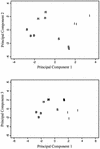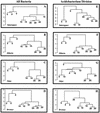Comparison of soil bacterial communities in rhizospheres of three plant species and the interspaces in an arid grassland
- PMID: 11916705
- PMCID: PMC123825
- DOI: 10.1128/AEM.68.4.1854-1863.2002
Comparison of soil bacterial communities in rhizospheres of three plant species and the interspaces in an arid grassland
Abstract
Soil bacteria are important contributors to primary productivity and nutrient cycling in arid land ecosystems, and their populations may be greatly affected by changes in environmental conditions. In parallel studies, the composition of the total bacterial community and of members of the Acidobacterium division were assessed in arid grassland soils using terminal restriction fragment length polymorphism (TRF, also known as T-RFLP) analysis of 16S rRNA genes amplified from soil DNA. Bacterial communities associated with the rhizospheres of the native bunchgrasses Stipa hymenoides and Hilaria jamesii, the invading annual grass Bromus tectorum, and the interspaces colonized by cyanobacterial soil crusts were compared at three depths. When used in a replicated field-scale study, TRF analysis was useful for identifying broad-scale, consistent differences in the bacterial communities in different soil locations, over the natural microscale heterogeneity of the soil. The compositions of the total bacterial community and Acidobacterium division in the soil crust interspaces were significantly different from those of the plant rhizospheres. Major differences were also observed in the rhizospheres of the three plant species and were most apparent with analysis of the Acidobacterium division. The total bacterial community and the Acidobacterium division bacteria were affected by soil depth in both the interspaces and plant rhizospheres. This study provides a baseline for monitoring bacterial community structure and dynamics with changes in plant cover and environmental conditions in the arid grasslands.
Figures




References
-
- Barth, R. C., and J. O. Klemmedson. 1978. Shrub-induced spatial patterns of dry matter, nitrogen, and organic carbon. Soil Sci. Soc. Am. J. 42:804-809.
-
- Belnap, J., and K. T. Harper. 1995. Influence of cryptobiotic soil crusts on elemental content of tissue of two desert seed plants. Arid Soil Res. Rehabil. 9:107-115.
-
- Belnap, J., and S. Phillips. 2001. Soil biota in an ungrazed semi-arid grassland: response to an exotic annual grass invasion. Ecol. Appl. 11:1261-1275.
-
- Belnap, J., K. T. Harper, and S. D. Warren. 1994. Surface disturbance of cryptobiotic soil crusts: nitrogenase activity, chlorophyll content, and chlorophyll degradation. Arid Soil Res. Rehabil. 8:1-8.
Publication types
MeSH terms
Substances
LinkOut - more resources
Full Text Sources
Other Literature Sources

